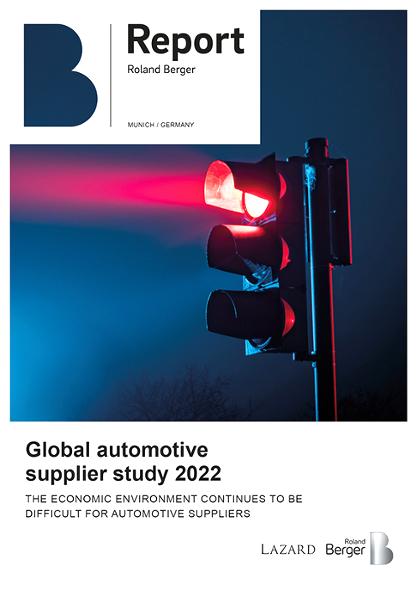Find out which impact the rise of new Chinese EV makers could have on traditional OEMs on the global automotive market.


Global Automotive Supplier Study 2022
By Felix Mogge and Florian Daniel
Three successive years of crisis - Automotive suppliers on the brink?
Automotive suppliers are facing a slew of challenges that are pressuring their margins and growth, according to a new study by Roland Berger and Lazard. Here's what’s expected for the supplier industry in the coming year.

After what seems like a never-ending series of ongoing uncertainties, the automotive supplier industry is facing its third consecutive year of slumping volumes, according to “Global Automotive Supplier Study 2022”, by Roland Berger and Lazard. Although average profit margins have returned to pre-pandemic levels, several lingering disruptions and many new challenges to ramp up the pressure on supplier margins and growth over the short-term. The difficulties are caused primarily by semiconductor shortages and skyrocketing material prices, and especially in Europe, soaring energy prices.
Taking a deeper look at profitability levels under these circumstances, reveals that the average margin of 5.3% is in fact strongly influenced by aftermarket players, electronics suppliers, and Asian driven process specialists. All of these groups are able to outperform the market by far due to current market specifics.
8 sources of automotive supplier squeeze
Looking in detail at the challenges for the global automotive supplier industry, the study by Roland Berger and Lazard outlines eight sources contributing to the margin deterioration over recent months:
- Semiconductor shortages. Constrained supplies are still holding the industry hostage and we do not expect the situation to ease anytime soon.
- Geopolitical events. These include the war in Ukraine, rising inflation, and higher credit rates, all of which increase supplier costs.
- Freight costs. Related to the above, these have remained high as well, further reducinges supplier margins.
- Unclear volume forecasts. Since the vehicle production outlook is uncertain, not to mention filled with short-term order volatility, suppliers are struggling to accurately forecast their volumes.
- Industry transformation. Despite changing macroeconomics, OEMs are pressuring suppliers to keep costs downs and showing a lack of willingness to step out of established supplier relationship patterns.
- Vertical integration. Moving forward, OEMs are expected to insource certain EV systems, which could further reduce supplier orders.
- Fastest growing market in question. The future of China as a powerhouse of the automotive industry is uncertain.
- Increasing financing costs. Central banks fighting global inflation by raising interest rates will make refinancing for automotive suppliers significantly more expensive.
"Inflation, semiconductor shortages as well as increasing material and factor cost set back the automotive supplier industry. Although some players outperform the market, in the light of low production volumes a turnaround is not expected before 2025."
Getting answers
While the industry was expecting a recovery from Covid-19 and the semiconductor crisis in 2022, Russia's war in Ukraine brought everyone down to earth with a bump. The implications worked out by Roland Berger and Lazard will persist in the mid-term. Markets face the risk falling into a longer-lasting recession, which might push a return to pre-crisis volumes out to the end of the decade.
Regardless of region, company size, or product focus, automotive suppliers must put themselves in a favorable position to overcome these challenges and transition to the future of automotive supply. Doing so might even increase margin pressure further, as continuous investments in technologies for the ongoing industry transformation are required.
To learn more about the increasing short-term disruptions facing automotive suppliers today, including specific impacts, ways of coping with these challenges, and the financial health of suppliers, please read the full report. For additional information, please contact us - we are here to help, offering decades of experience in the automotive industry.
Register now to download the full “Global Automotive Supplier Study 2022” including key insights, new developments as well as future challenges for players in the industry. Additionally, you get regular insights into automotive topics.

![Production volume passenger cars by region, 2018-2923e [million units]](https://img.rolandberger.com/content_assets/content_images/captions/Roland_Berger_INS_907_Global_automotive_supplier_study_GT_01-(1)_image_caption_none.jpg?v=770441)




_tile_teaser_h314x380.jpg?v=770441)

